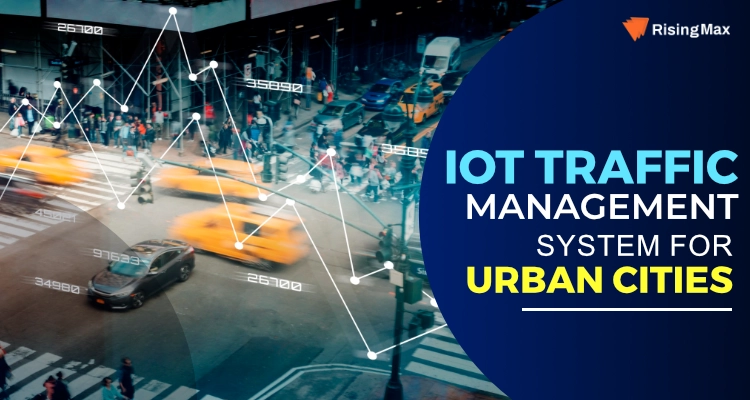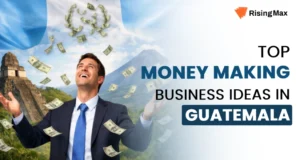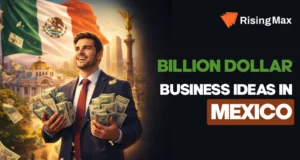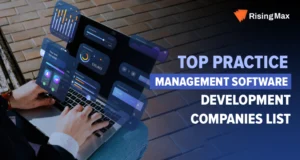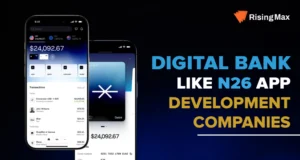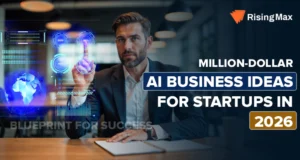Welcome to the future of urban mobility with RisingMax Inc.’s groundbreaking IoT traffic management system. As cities grow and traffic congestion intensifies, our innovative solution revolutionizes transportation management. By seamlessly integrating cutting-edge IoT technology, real-time data analytics, and intelligent traffic control, we empower cities to optimize traffic flow, reduce congestion, and enhance commuter experiences. Join us in shaping smarter, more connected urban landscapes where efficiency and sustainability converge to define a new era of traffic management excellence.
Ready to Transform Urban Mobility? Embrace the Future with our IoT Traffic Management System. See the City Unveil it's True Potential – Request a Demo Today!What Is The Internet of Things (IoT)?
The Internet of Things (IoT) refers to a network of interconnected physical devices, vehicles, appliances, and other objects embedded with sensors, software, and connectivity capabilities that enable them to collect, exchange, and transmit data. This data can be gathered, analyzed, and utilized to facilitate communication, automation, and smart decision-making, enhancing efficiency, convenience, and insights across various industries and everyday life.
Upgrade Today for Efficient Roads: Elevate Traffic Control, Reduce Jams Boosts Safety & More With IoT.
Role Of IoT In Traffic Management
The role of IoT in traffic management is transformative, introducing a paradigm shift in how cities optimize and regulate their transportation systems. By embedding sensors and connectivity into vehicles, roads, traffic lights, and other infrastructure, IoT enables the collection of real-time data on traffic patterns, congestion, vehicle movements, and more. This data is then processed and analyzed to make informed decisions, dynamically adjusting traffic signals, rerouting vehicles, and improving overall traffic flow. This intelligent management level enhances road safety, reduces congestion, lowers emissions, and creates more efficient and sustainable urban mobility systems.
How IoT Is Used In Traffic Congestion?
IoT is pivotal in alleviating traffic congestion by orchestrating a smarter, data-driven traffic management system. Real-time data on vehicle flow, road conditions, and congestion patterns are collected through a network of interconnected sensors, cameras, and devices. This information is analyzed to optimize traffic signal timings, reroute vehicles dynamically, and provide real-time updates to commuters. IoT enables predictive modeling, allowing authorities to anticipate congestion-prone areas. By harnessing IoT’s capabilities, urban planners and authorities can create more efficient traffic flow, reduce travel times, and minimize environmental impact, fostering a smoother and more sustainable urban mobility experience.
Also Read: IoT Application Development
IoT Features That Will Help Traffic Management System
Certainly, here are nine features of IoT that contribute to an effective traffic management system:
Real-Time Traffic Monitoring
IoT sensors installed on roads and vehicles provide real-time data on traffic congestion, vehicle density, and movement patterns, enabling instant response to changing conditions.
Smart Traffic Signals
IoT-connected traffic lights can adjust their timing based on traffic flow, minimizing congestion and reducing commuter waiting times.
Predictive Analytics
IoT-driven data analysis helps predict traffic patterns and peak hours, allowing authorities to proactively implement preemptive measures and manage traffic.
Dynamic Route Optimization
IoT-powered navigation systems offer real-time route suggestions considering current traffic conditions, ensuring drivers are directed through the least congested routes.
Vehicle-to-Infrastructure Communication
IoT-enabled vehicles can communicate with road infrastructure, such as traffic lights, to receive optimized routing suggestions and reduce idling time.
Parking Management
IoT sensors in parking lots detect available spaces, guiding drivers to open spots and reducing the time spent searching for parking.
Emergency Response Coordination
IoT facilitates communication between emergency vehicles and traffic management systems, enabling the prioritized passage of ambulances, fire trucks, and police vehicles.
Eco-Friendly Solutions
IoT aids in reducing emissions by optimizing traffic flow, decreasing idling time, and promoting carpooling, ultimately contributing to more sustainable urban environments.
Data-Driven Insights
IoT-generated data helps city planners identify traffic patterns, plan infrastructure improvements, and make informed decisions to optimize transportation networks.
These IoT features collectively create a more intelligent, efficient, and responsive traffic management ecosystem, reducing congestion, improving safety, and enhancing mobility for urban residents.
Benefits Of Integrating IoT In Traffic Management System
Certainly, here are nine benefits of integrating IoT in a traffic management system:
Enhanced Traffic Flow
IoT-enabled real-time data analysis allows dynamic traffic signal adjustments, minimizing congestion and ensuring smoother traffic flow.
Reduced Congestion
IoT sensors provide accurate insights into traffic patterns, enabling authorities to implement strategies that alleviate congestion and prevent bottlenecks.
Improved Road Safety
IoT-equipped vehicles and infrastructure can communicate to prevent collisions, alert drivers about hazardous conditions, and facilitate safer driving behaviors.
Optimized Route Planning
IoT-powered navigation systems offer drivers real-time route suggestions based on current traffic conditions, leading to faster and more efficient journeys.
Energy Efficiency
IoT-driven traffic management reduces unnecessary vehicle idling, leading to lower fuel consumption, reduced emissions, and a greener urban environment.
Accurate Data Collection
IoT sensors capture precise traffic data, helping city planners make informed decisions about road infrastructure and transportation policies.
Emergency Response Enhancement
IoT facilitates faster response times for emergency vehicles by clearing paths and coordinating traffic signals, potentially saving lives.
Smart Parking Solutions
IoT-connected parking systems guide drivers to available parking spots, reducing congestion caused by searching for parking spaces.
Sustainable Urban Planning
By optimizing traffic management through IoT, cities can create more livable, environmentally friendly urban areas that prioritize efficient transportation and reduce pollution.
Incorporating IoT into traffic management systems increases efficiency, safety, and sustainability, ultimately enhancing the quality of life for urban residents while addressing the challenges of modern urban mobility.
Also Read: Future Of Connected Cars “Internet Of Things” In Automotive Industry
Major Application Of IoT In Traffic Management System
Certainly, here are six key applications of IoT in traffic management:
Smart Traffic Signals
IoT-connected traffic signals adjust in real-time based on traffic conditions, reducing congestion and improving traffic flow.
Intelligent Parking Systems
IoT sensors detect available parking spaces and transmit data to navigation apps, helping drivers find parking quickly and minimizing traffic caused by searching for spots.
Traffic Analytics and Prediction
IoT-enabled data collection and analysis predict traffic patterns, allowing authorities to prevent congestion during peak hours or events proactively.
Connected Vehicles
IoT-equipped vehicles communicate with each other and infrastructure, enhancing safety by alerting drivers about potential collisions or hazards and enabling adaptive cruise control.
Emergency Vehicle Management
IoT systems facilitate the smooth passage of emergency vehicles by coordinating traffic signals and minimizing response times during critical situations.
Public Transportation Optimization
IoT sensors on buses and trains provide real-time data on vehicle locations, allowing passengers to track arrivals and departures accurately and aiding in route planning for more efficient public transportation systems.
These applications highlight how IoT technology can significantly improve the efficiency, safety, and overall effectiveness of traffic management systems in urban areas.Use Cases Of IoT Traffic Management System
Certainly, here are three use cases of IoT traffic management systems:
Dynamic Traffic Signal Control
IoT sensors placed at intersections collect real-time data on traffic flow. This data is then analyzed to adjust traffic signal timings dynamically. When traffic is heavy on one road, the system automatically extends the green signal, reducing congestion and improving overall traffic flow.
Smart Parking Management
IoT-enabled parking lots and street parking spaces are equipped with sensors that detect occupancy. This information is transmitted to a central system, which relays real-time availability to drivers via mobile apps or digital signs. This minimizes time spent searching for parking, reduces traffic congestion, and optimizes parking space usage.
Connected Vehicle Communication
Vehicles equipped with IoT technology communicate with each other and with road infrastructure. In scenarios where a vehicle suddenly brakes, it can signal nearby vehicles to warn them and potentially avoid collisions. This vehicle-to-vehicle and vehicle-to-infrastructure communication enhances road safety and prevents accidents.
Traffic Congestion Analytics and Prediction
IoT sensors gather data from various points across the city to monitor traffic congestion. The system can predict future congestion areas by analyzing historical and real-time data. This information helps authorities take proactive measures such as rerouting traffic, adjusting signal timings, or providing alternative transportation options.
Emergency Response Coordination
IoT-equipped emergency vehicles and traffic management systems collaborate to ensure swift and safe passage during emergencies. Traffic signals along the route can be pre-programmed to turn green as the emergency vehicle approaches, minimizing response time and potentially saving lives.
Pedestrian Safety Enhancement
Crosswalks and intersections are equipped with IoT sensors that detect the presence of pedestrians. When someone is about to cross, the system alerts drivers by changing traffic signal patterns or displaying warning signs. This reduces accidents involving pedestrians and promotes safer interactions between vehicles and pedestrians.
These use cases illustrate how IoT technology can revolutionize traffic management by making it more efficient, responsive, and safer for drivers and pedestrians.
Also Read: Use Case Of IoT In The Metaverse
Cost To Build IoT Traffic Management System
Building an IoT traffic management system involves various factors that can impact the overall cost. Here are six key points to consider:
Infrastructure Development
Establishing the necessary physical infrastructure, such as sensors, cameras, and communication networks, increases initial costs. This includes installation, wiring, and connectivity setup.
Software Development
Developing the central software platform for data aggregation, analysis, and control involves programming, database setup, and user interface design. This includes costs for hiring developers or outsourcing the development.
Connectivity Expenses
IoT devices need a reliable communication network, which may involve cellular, Wi-Fi, or other connectivity options. Subscription fees or data usage charges can contribute to ongoing costs.
Data Storage and Processing
Storing and processing the collected data requires cloud infrastructure or on-premises servers. Costs include server maintenance, data storage fees, and potential scalability expenses.
Maintenance and Support
Over time, system maintenance, updates, and customer support are essential. This includes troubleshooting, addressing software bugs, and ensuring hardware components remain functional.
It’s important to note that costs can vary widely depending on the scale of the system, the complexity of features, geographic factors, and technology choices. A comprehensive cost assessment should consider these variables to provide an accurate estimation for your specific IoT traffic management system. The Approximate cost to build a reliable solution can lie between $85000 to $135000; it could be more or less according to the requirements and features.
Unleash data-driven management. Cut congestion, elevate safety.
How RisingMax Inc. Can Help You In IoT Traffic Management System Development
RisingMax Inc. is pivotal in revolutionizing your city’s IoT traffic management system through innovative IoT solutions. Here’s how we can assist you:
Tailored IoT Integration
We specialize in seamlessly integrating IoT technology into your existing traffic infrastructure. Our experts customize solutions that align with your city’s unique traffic patterns, ensuring a smooth transition and minimal disruption.
Comprehensive Sensor Deployment
We deploy IoT sensors strategically at key intersections, roadways, and parking areas. These sensors gather real-time data on traffic flow, vehicle density, and parking occupancy, providing accurate insights for efficient decision-making.
Advanced-Data Analytics
Our cutting-edge analytics platform processes the collected data, generating actionable insights and predictive models. This enables you to anticipate congestion, plan for events, and optimize traffic flow, reducing commute times and enhancing urban mobility.
Dynamic Traffic Control
We empower you with real-time traffic signal control. You can remotely adjust timings based on traffic conditions through IoT-enabled signals, alleviating congestion and ensuring smoother traffic movement.
Smart Parking Solutions
We implement IoT sensors in parking areas, guiding drivers to available spaces in real-time through mobile apps or digital displays. This minimizes traffic congestion caused by parking searches, enhancing overall city efficiency.
Emergency Response Enhancement
Our IoT system facilitates seamless communication between emergency vehicles and traffic signals. This ensures prioritized passage for first responders, reducing response times during critical situations.
User-Friendly Interfaces
We provide user-friendly dashboards and mobile apps that allow city officials and residents to access real-time traffic information, plan routes, and receive alerts, promoting efficient commuting.
Scalable Solutions
Whether you’re managing a small urban area or a bustling metropolis, our IoT solutions are scalable and adaptable to suit your city’s growth and changing traffic dynamics.
Partner with RisingMax Inc. to unlock the potential of IoT in traffic management. Together, we'll create a smarter, safer, and more efficient urban mobility experience for your residents and visitors.
